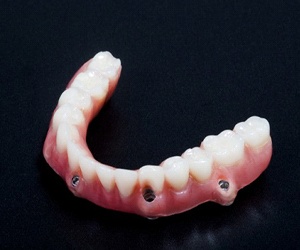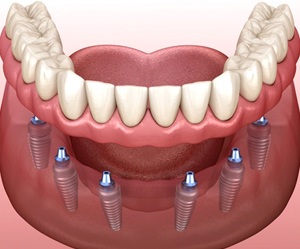








Dental implants are already incredibly comprehensive thanks to their major restorative properties. But what if we told you that you could replace all the teeth in your arch with just a handful of dental implants? That’s where implant-retained dentures come in. Thanks to their versatility, it’s easy to replace teeth on opposite sides of your mouth or all the teeth in your top or bottom arch. To learn how the process works, keep reading or give RiverPlace Dental a call today!

While single dental implants are designed to hold one restoration, such as a porcelain crown, a series of implants can be used to hold either a full or partial denture. Each implant is placed directly into your jaw and given several months to integrate with your existing bone tissue. Since implants are strong enough to hold restorations on their own, you don’t have to rely on existing teeth to keep the restoration in place. This is the biggest difference between traditional and implant-retained dentures. The number of implants needed can vary, but we’ll make sure you’re aware of how many you’ll need to undergo the procedure.

If you have good oral health overall, especially healthy gum tissue and sufficient bone volume, you’re likely a viable candidate for implant-retained dentures. Having healthy bone volume is crucial to the implants integrating with your jaw for the long-term. Healthy gums are necessary because they need to be able to heal around the implant after it has been placed. If additional treatments are needed for you to receive implant-retained dentures, we’ll make sure to help you prepare for those treatments as part of your overall plan. Keep in mind that most patients are eligible for implant-retained dentures, even if they’ve had missing teeth for a long time.

Placing and restoring dental implants can take a lot of planning, but we’ll make sure that you’re informed of each phase of treatment. After confirming your oral health status and carefully examining your many oral structures, we’ll schedule you for treatment at a later date. At your appointment, the implants will be placed and given time to heal over the next several months. Once they’ve had a chance to integrate with your bone and gum tissue, a series of abutments will be attached. These components act as stabilizers for your permanent denture. To create the denture, an impression of your implants is captured, then sent to an offsite dental lab for fabrication. Once the permanent denture is created, you’ll come back to our office to have the denture placed.
When you choose dental implants to hold your next denture, you’re getting a restoration that is far more stable compared to a traditional full or partial denture. There’s no worry of your denture slipping and sliding out of place, nor should you be worried about your jawbone deteriorating. Thanks to the constant stimulation dental implants provide, you’re able to eat the foods you enjoy, smile naturally, practice daily oral care with ease, and have the confidence that your smile will last longer than ever before.